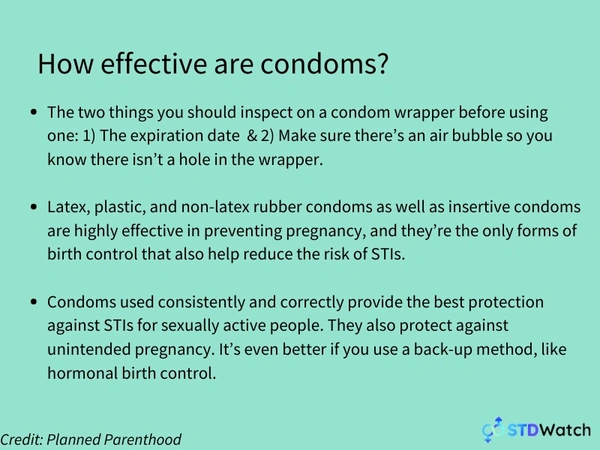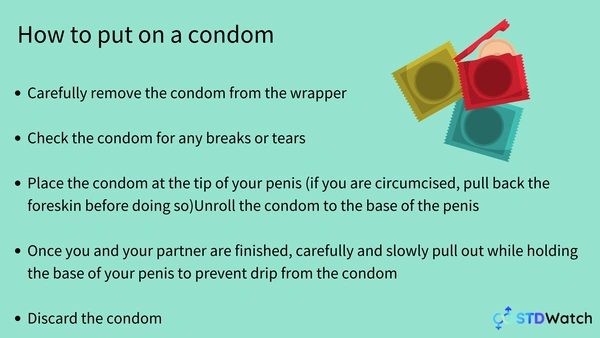How effective are condoms?
Male condoms are 98% effective at preventing pregnancy if used correctly each time.
The simple fact is, we don’t always do things correctly. According to Planned Parenthood, real life condoms are about 85% effective — that means about 15 out of 100 people who use condoms as their only birth control method will get pregnant each year.
This would mean that in ideal circumstances, male condoms have a 2% failure rate, but in real life, they carry a 15% failure rate.
For this reason, it is recommended that hormonal birth control is used in conjunction with condoms to ensure that both you and your partner are protected every time.
How effective are other types of contraception?
If you are hoping to prevent getting a sexually transmitted infection, and pregnancy. It’s important that you are using condoms, and another form of contraception.
While hormonal contraceptives and IUDs are effective for preventing pregnancy, condoms are essential for protecting your sexual health.
Let’s talk through the efficiency of hormonal contraception as well as intrauterine contraception.
Hormonal contraception
- Implant (female) - failure rate (0.1%). An implant is progestin rod that is implanted into a female’s upper arm.
- Injection (female) - failure rate (4%). An injection of progestin into the upper arm or buttocks. This injection is administered by a doctor every three months.
- The pill (female) - failure rate (7%). A pill containing progestin and and estrogen that is taken at the same time every day. A progestin only pill also carries a 7% failure rate.
- The patch (female) - failure rate (7%). A progestin and estrogen “plaster” which can be placed on the lower abdomen, buttocks or upper body. Users must place a new patch on every week, three weeks per month.
- The ring (female) - failure rate (7%). A progestin and estrogen ring that is placed in the vagina. The ring appears like a more sturdier elastic band. The ring is placed in the vagina for three weeks per month.
- Diaphragm (female) - failure rate (17%). Diaphragms are shallow cups that are placed inside the vagina to cover the cervix to block sperm.
- Sponge (female) - failure rate (14% in women who have never had children, 27% in women who have had children). Sponge are placed over the cervix. The sponges which contain spermicide works for up to 24 hours. Sponges need to left in the vagina for a minimum of 6 hours following sex.
- Female condom (female) - failure rate (27%). Female condoms work in a similar way to male condoms. Female condoms can be inserted up to eight hours before having sex.
- Levonorgestrel intrauterine system (LNG IUD) (female) - failure rate (01-0.4%). A small progestin releasing T-shaped device that is placed inside the uterus by a doctor. This device can remain in the uterus for 3-6 years.
- Copper T intrauterine device (IUD) (female) - failure rate (0.8%). A small progestin releasing T-shaped device that is placed inside the uterus by a doctor. This device can remain in the uterus for 10 years.
- Spermicides (male) - failure rate (21%). Spermicides can come in foam, gel, cream, film, suppository, or tablet format. They are placed in the vagina one hour or less before having sex. Spermicides prevent pregnancy by killing sperm.
Failure rates taken from the Centers for Disease Control and Prevention.
How do you put on a condom?
- Carefully remove the condom from the wrapper
- Check the condom for any breaks or tears
- Place the condom at the tip of your penis (if you are circumcised, pull back the foreskin before doing so)
- Unroll the condom to the base of the penis
- Once you and your partner are finished, carefully and slowly pull out while holding the base of your penis to prevent drip from the condom
- Discard the condom
Read: How to put on a condom plus facts & myths for the full low down on how to use condoms.
Is it risky to use “ultra thin” condoms?
It is not risky to use “ultra thin” condoms. They do not break more easily than regular or “ultra safe” condoms. All condoms that are currently on the market have undergone rigorous testing.
Planned Parenthood recommends that condoms made of latex, polyurethane, and polyisoprene offer the best protection against STDs, while natural condoms made of lambskin offer the least.
What should I do if I think I’m allergic to condoms?
If you continuously feel itchy after sex, consider trying condoms that are made of polyurethane and polyisoprene, or switching up your lubricant to something more natural. You should consider getting tested if you are concerned that the itching could be caused by a sexually transmitted disease.
Why do I find it difficult to use condoms?
When it comes to using condoms, practice makes perfect! There are a number of reasons that males or females may find using condoms difficult.
Males may find condoms difficult to use because they are the wrong size, they have had previous unpleasant experiences, or they are allergic to the materials of the condoms.
Females may find condoms difficult to use due to an unpleasant experience in the past, allergies, or the condom is not sufficiently lubricated.
Remember that every single person is unique and using condoms is different for every person. If you are struggling to use condoms, there are tonnes of great resources out there to help.
Take your time, and know that no one starts off as a pro. Try putting condoms on yourself in a solo setting a couple of times. You will be a pro in no time!
FAQs
Why do condoms fail?
Condoms can fail for a number of reasons:
- The condom may have been placed incorrectly on the penis.
- The condom could have broken due to friction during sex.
- The condom could fall off during sex.
- The condom could have broken while in the packet.
Do condoms take away feeling?
Condoms don’t necessarily take the feeling away for either party during sex. It really comes down to personal preference, however condoms are really the only way to protect against sexually transmitted diseases so if you are hoping to achieve optimum sensitivity, it may be an idea to use ultra-thin condoms.
Do condoms make it easier to go in?
When it comes to inserting the penis during intercourse, a water-based lubricant is your best friend! Most condom brands are lubricated but if you are finding insertion difficult, invest in additional lube.
Also ensure that you engage in enough foreplay so your female partner is physically ready.
For MSM (men who have sex with men), ensure that both you and your partner take it slow, and use enough lubrication.
Keep lines of communication open and honest so you know that both parties are ready to go in all instances.
Written by Hannah Kingston, April 8, 2021
Resources
- How effective are condoms? - plannedparenthood.org
- Contraception - cdc.gov
- How to put on a condom plus facts & myths - stdwatch.com
- Do ultra thin condoms break easily? - plannedparenthood.org




